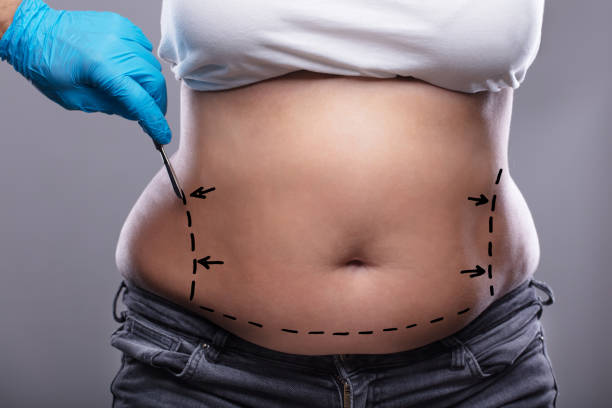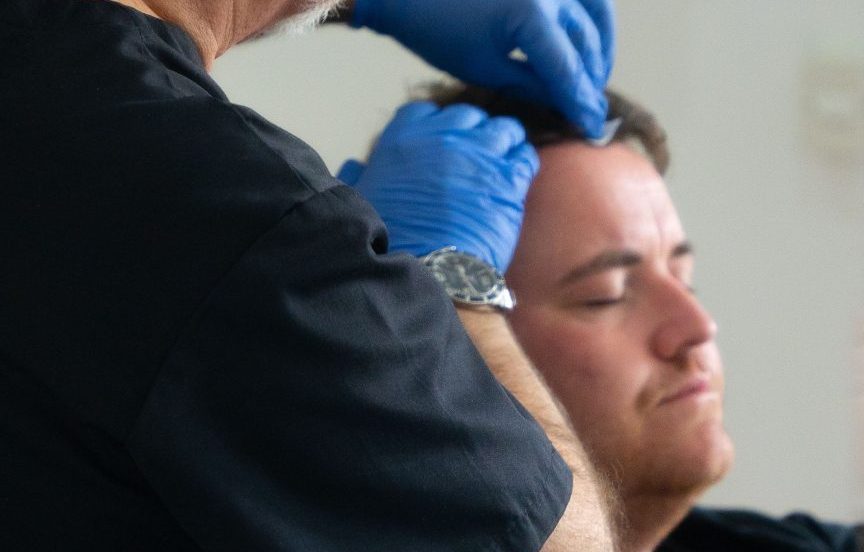
The Tummy Tuck Process (Abdominoplasty): From Consultation to Recovery
The Tummy Tuck Process (Abdominoplasty): From Consultation to Recovery
Discover the tummy tuck process, from consultation to recovery. Learn how abdominoplasty transforms your body safely!
If belly fat is hanging around like it’s got a VIP pass to your body, you’re not alone—it’s got a knack for overstaying its welcome! Excess abdominal fat, particularly visceral fat, isn’t just a cosmetic concern—it can seriously impact your health. This type of fat, which wraps around your organs, is linked to an increased risk of chronic conditions such as type 2 diabetes, heart disease, and other metabolic diseases.
Although life changes, including reduced alcohol intake, increased protein consumption, and regular weight training, can successfully reduce abdominal fat, such efforts often are not good enough. That is where abdominoplasty, or tummy tucks, comes in. The surgery will get you that flat, firmer abdomen you wish for after losing weight, after pregnancy, or due to ageing by removing the excessive skin and fat and tightening muscles for a more youthful look.
This guide will walk you through the entire tummy tuck process, from consultation to recovery so that you can make an informed and confident decision regarding your transformation.
Abdominoplasty, known as tummy tuck, is a cosmetic surgery to restructure and improve the look of your abdomen. If you have struggled with loose skin or fat in your belly or your lower abdominal muscles have grown weak or separated, this surgery may help your tummy once again be smooth and firm.
It consists of removing surplus skin and fat and the tightening of connective tissue-the fascia-in the abdomen with sutures. Once the muscles have firmed up, the remaining skin is positioned for a smoother, more contoured appearance. The result is a flatter, toned belly that looks and feels great.
Due to much weight loss, pregnancy, or the simple ageing process, a tummy tuck may be needed to get into the shape you have always hoped for. It is not only a matter of how the abdomen will look; it can make a huge difference in how you feel about your body.






Types of Tummy Tucks
When it comes to tummy tucks (abdominoplasty), there is no one-size-fits-all solution. Depending on your specific needs and goals, there are a few types of tummy tucks to consider. Let’s take a look at each one:
The standard tummy tuck or abdominoplasty is the most common abdominoplasty type and focuses on the upper and lower abdomen. In this procedure, your surgeon will make a horizontal incision just above your pubic bone, going from hip to hip.
Excess skin and fat are eliminated, and weakened or separated abdominal muscles are especially important for people with diastasis recti or separated abdominal muscles. This type is ideal for those who want to tighten both the upper and lower areas of the belly. While it has a longer recovery time, most patients can return to non-strenuous work after a couple of weeks, though it takes about three months to recover fully.
A mini tummy tuck is a more conservative procedure that targets the lower abdomen beneath the belly button. A smaller incision is used. How much extra skin there is determines the incision’s length and contour;
The procedure is quicker, downtime is less, and most people return to work in a week or two. However, the results are limited to the lower abdomen. Therefore, it is best for people who do not have significant upper abdominal complaints
An extended tummy tuck, also known as full abdominoplasty is your best resort if you have loose skin in the flanks or sides, other than the abdomen, and usually referred to as love handles. The extended incision for this procedure goes around your flanks, shaping the waist, hips, and abdomen. It is ideal for people with more serious sagging and resistant fat deposits. Liposuction can be combined to remove the resistant deposits of fat.
Recovery takes four to six weeks before returning to work and up to three months for complete recovery. Each of these abdominoplasty varieties caters to different needs, and the best will vary depending on your body and aesthetic goals. Your surgeon will guide you to the right option for the results you’re hoping for.
Key Benefits of a Tummy Tuck
Let’s face it-abdominoplasty isn’t all about looking good; one may come up with an enclosure full of advantages associated with abdominoplasty. Sure, the aesthetic benefits are understandable, but there are surprising medical advantages to be found-especially when the surgery corrects a condition or two.
Here’s how abdominoplasty can do much more than just flatten your stomach:
To Correct a Ventral Hernia
A ventral hernia occurs when your intestine or abdominal tissue bulges through your abdominal wall to form a pouch. This can occur following significant weight loss, an appendectomy, or even a C-section.
A tummy tuck can help correct this by strengthening those weak abdominal muscles, reducing pressure on the skin and giving you a flatter, stronger stomach.


To Reduce Stress Urinary Incontinence (SUI)
If you’ve ever laughed, sneezed, or coughed and suddenly found yourself awkward, you know how frustrating SUI can be. Stress urinary incontinence usually occurs when there is too much pressure in the bladder, causing accidental leaks; this is normally treated with non-surgical methods.
A tummy tuck can help in treating it, too! This will help remove some pressure from your bladder by clamping down on it with your abdominal muscles. It is a common complaint for women after having given birth, but men experience it as well.
For Decreasing Lower Back Pain
Do you have lower back pain from after your childbearing days or after sudden weight loss?
Well, you are not alone. So many women, and also men, do experience back aches due to weak stomach muscles. A tummy tuck tightens these muscles by removing excess fat, offering the spine support and relief against such nagging pains.
Improving Your Posture
If you have ever caught yourself slouching or stiff in the back, a tummy tuck could help with that, too. With stronger abdominal muscles and less pain, you might notice you stand taller, walk straighter, and feel more confident. The tightened muscles support your spine, improving posture almost automatically!
So, if you’re considering a tummy tuck, know it’s not just about looking great—it could also make a real difference in how you feel daily!
Who is the Best Candidate
for an Abdominoplasty
Considering a tummy tuck? That is a great way to get a smoother, more toned abdominal area, but who should consider it? Let’s break this down for you! Common Reasons People Undergo a Tummy Tuck:
1. Abundance of skin and fat around the abdominal area
If you have resistant fat or loose skin in the abdomen that won’t budge no matter how much you diet or exercise, know you are not alone. Caused by pregnancy, weight loss, and even ageing, a tummy tuck is created to remove this excess skin and fat. The result is a smooth, more sculpted midsection that may make you feel like you’re rediscovering a whole new body.
2. Weakened Abdominal Muscles
Our abdominal muscles can weaken, especially after pregnancy or significant weight changes. This can lead to a protruding belly, often called a “pooch,” which can be frustrating, especially if you’re doing everything right with your fitness routine.
A tummy tuck helps by tightening and repairing these muscles, restoring strength and stability, and giving your waistline a more defined, toned look.

3. Done Having Children? Tummy Tuck Could Be for You
This is very important. If you think you will have more children in the future, it’s best to delay your tummy tuck until later. Pregnancy will make your skin and abdominal muscles stretch out, which could affect your surgical outcome.
Therefore, if you’ve completed your family planning and are not thinking of more little ones, you are likely a perfect candidate for the procedure.
4. For Stable Weight Purpose
Before you consider having a tummy tuck, your weight should have stabilised. If your weight fluctuates, expecting a good outcome from this surgical procedure is not wise. This will be best if you wait until your weight has remained steady for at least some months. After your weight stabilises, you’ll be well-placed to benefit from the surgery.

5. For Good Health’s Sake
As with any surgery, general good health is important. Certain medical conditions, such as uncontrolled diabetes and heart disease, can increase the risks associated with surgery.
Your surgeon will review your medical history during your consultation to determine if you are a good candidate for the procedure. The whole point is to ensure you are healthy enough for a safe and successful surgery.
6. Choosing the Healthy Lifestyle
Before you consider having a tummy tuck, your weight should have stabilised. If your weight fluctuates, expecting a good outcome from this surgical procedure is not wise. This will be best if you wait uaLiving a healthy lifestyle can help support your tummy tuck’s long-term success. If you’re a smoker, you must give up for several weeks, both pre- and post-surgery, as nicotine interferes with your recovery. Eating a well-balanced diet and exercising also tend to keep the result from your tummy tuck positive, making your abdomen firmer and tighter for much longer.
ntil your weight has remained steady for at least some months. After your weight stabilises, you’ll be well-placed to benefit from the surgery.
7. Extreme Weight Loss
Congratulations, you have lost a lot of weight! That is great, but sometimes, that causes your skin not to snap back anymore. A tummy tuck is an ideal procedure in cases of major weight loss that has resulted in loose and sagging skin. The surgery removes that extra skin and tightens one’s abdominal muscles to give them the finished look they’ve fought so hard to see.
If any of those sound like you, then now is the time to see what a tummy tuck can do for you. A consultation with a skilled surgeon will go a long way in helping determine if you are a good candidate and exactly how this type of procedure will help you attain the desired results. It’s all about being comfortable and confident in your skin!
The Tummy Tuck Process: Step-by-Step Guide
This method consists of the following steps: First, check the presurgery notes.
Pre-Surgery Checklist
Enough preparation is crucial for a successful tummy tuck procedure. Use this checklist to ensure you’re fully ready:
- Medical Assessment: Undergo a comprehensive health evaluation to confirm you’re fit for surgery. This may include blood tests and any additional exams recommended by your surgeon.
- Medication Review: Consult with your surgeon about the medications you’re taking. Certain drugs can raise the risk of bleeding, and you may need to pause them before surgery.
- Cease Smoking: If you smoke, it’s important to quit at least a few weeks before and after the surgery. Smoking can slow down healing and raise the likelihood of complications.
- Arrange Assistance: Make arrangements for someone to help you during the initial stages of your recuperation and drive you home after the procedure.
Initial Consultation: What to Expect
The consultation is a crucial part of your tummy tuck journey. During this meeting, you’ll outline your goals, gain a comprehensive understanding of the procedure, and get both physically and psychologically ready for the procedure.
- Medical History: Your surgeon will go through your medical background, including any previous surgeries, current medications, and allergies. Be open and detailed to ensure your safety.
- Physical Assessment: The surgeon will assess your abdomen to evaluate the condition of the skin and muscles. This examination helps determine the most suitable tummy tuck option for you.
- Goal Discussion: Clearly communicate your expectations and desired results. You can show photos or examples to help the surgeon visualise your goals.
- Surgical Plan: The surgeon will describe the process, review anaesthesia options, and give preparation instructions. The advantages and disadvantages of making an informed choice will also be covered.
- Questions and Concerns: Don’t be afraid to ask questions. Prepare a list beforehand to ensure all your concerns are addressed. A clear understanding of the procedure helps reduce anxiety and sets realistic expectations.
Tummy Tuck Surgery (Abdominoplasty): What Happens During the Procedure?
Knowing the steps of a tummy tuck surgery can help alleviate any concerns. Here’s what to expect:
- Anaesthesia: The procedure begins with anaesthesia to ensure you remain comfortable and pain-free. Your surgeon will either use general anaesthesia or intravenous sedation, depending on your specific needs.
- Incision: Your doctor makes a horizontal incision between your pubic area and the belly button. The length and shape of the incision depend on the amount of excess skin; in some cases, an additional vertical incision may be required.
- Muscle Repair: The surgeon will tighten the abdominal muscles by bringing them together and securing them with stitches, helping to create a firmer abdominal structure.
- Excess Skin Removal: Any excess skin is carefully removed. If significant skin is in the upper abdomen, a further incision around the abdominal button may be necessary.
- Repositioning the Belly Button: The belly button is repositioned through a new opening and securely stitched into place.
- Closure: The surgeon will use sutures, skin adhesives, or clips to close the incisions. Drainage tubes might also be inserted beneath the skin to remove excess fluids.
Post-Surgery Care and Recovery
The duration of your recovery will depend on your procedure’s specifics and overall health and lifestyle. Recovery times can differ from person to person, but generally, it’s recommended to allow 4-6 weeks for initial healing after surgery. Scar maturation, however, may take longer.
It’s essential to collaborate with your surgeon to ensure proper healing. Consult your surgeon before resuming daily activities like driving, lifting, or exercising.
For the first weeks, it’s essential to refrain from intense physical activity, although light, short walks are recommended to encourage blood circulation. You will need to wear a compression garment to support your abdomen as it heals and helps your skin adjust to the new shape of your body. Your surgeon is dedicated to addressing any questions or concerns you may have during your recovery, providing timely responses and expert guidance.
Remember that proper aftercare is crucial in achieving optimal results, smoothing your recovery process and ensuring that the outcomes align with your expectations.
How Much Does a Tummy Tuck Cost?
A tummy tuck in the UK can cost anywhere from £7000 to £10,000. Following this, you may need to consider the expense of any follow-up care and consultations that your surgeon recommends.
Factors Affecting the Price of a Tummy Tuck
The total cost of a tummy tuck can vary due to several factors:
- Type of Tummy Tuck: Full abdominoplasty is typically more costly than mini tummy tucks because they require more extensive procedures and longer recovery periods.
- Surgeon’s Expertise: Surgeons with more experience and a strong reputation may charge higher fees, reflecting their skill level and the quality of outcomes they deliver.

- Facility Charges: The cost may increase depending on the hospital or surgical facility chosen. Facilities in premium locations or those offering state-of-the-art amenities often have higher fees.
- Anaesthesia Costs: The expense also depends on the type of anaesthesia used and the anesthesiologist’s qualifications. General anaesthesia is usually more expensive than local anaesthesia.
- Additional Costs: Post-surgical garments, prescribed medications, and follow-up appointments are other expenses for budgeting for a tummy tuck.
Insurance and Payment Options
Most tummy tucks are classified as elective procedures and are typically not covered by insurance. However, there are exceptions:
- Medical Necessity: Insurance may cover the procedure if it is deemed medically necessary, such as in cases where excess skin causes significant health issues.
- Partial Coverage: Some costs may be covered if the tummy tuck is part of a post-bariatric surgery plan or addresses a specific medical condition.
- Documentation: Extensive documentation is required to secure insurance coverage. This includes proof of medical necessity and evidence that alternative treatments have been unsuccessful.
Abdominoplasty in the UK With Merchant City Medical Group
A tummy tuck offers numerous benefits, from removing excess skin and fat to strengthening abdominal muscles and boosting self-confidence. This transformative process can help you achieve a smoother, firmer, and more contoured appearance.
At Merchant City Medical Group, our certified experts in the UK and Europe are committed to providing personalised advice and tailored treatment plans to ensure the best results for every patient.
Ready to transform your body? Book your free consultation with Merchant City Medical Group today and take the first step toward a more confident you!
Excellence Record
- 30+ Years of combined experience
- 10 + Experts
- 1000 + Satisfied Patients





